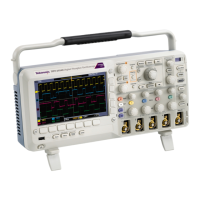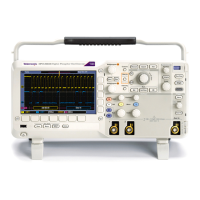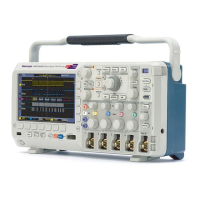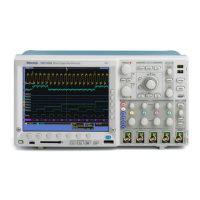Commands Listed in Alphabetical Order
Related Commands
MEASUrement:I
MMed:SOUrce1
MEASUrement:IMMed:SOUrce2
Arguments
<x> specifies which waveform to use, where <x> = 1 is the "from" waveform, and
<x> = 2 is the "to" waveform.
FALL specifies the falling edge.
RISe specifies the rising edge.
Examples
MEASUREMENT:IMMED:DELAY:ED GE1 RISE specifies that the "from" waveform
rising edge be used for the immediate delay measurement.
MEASUREMENT:IMMED:DELAY:ED GE1? returns either RISE or FALL.
MEASUrement:IMMed:SOUrce1
Sets or returns the source for all single source immediate measurements
and specifies the source to meas ure "from" when taking an immediate delay
measurement or phase measurement.
Digital channels (D<x>) are available as a measurement source for time, edge and
pulse measurements such as Period, Frequency, Pos Width, Neg Width, Pos Duty
Cycle, Neg Duty Cycle, Pos/Neg Edges and Pos/Neg Pulses, De
lay and Phase .
NOTE. If you do not specify a numerical suffix,thesourceisassumedtobe
SOURCE 1.
Group
Measurement
Syntax
MEASUrement:IMMed:SOUrce1 {CH<x>|MATH< y>|REF<x>}
MEASUrement:IMMed:SOUrce1?
Related Commands
MEASUrement:IMMed:SOUrce2
Arguments
CH<x> is an input channel waveform. The x variable can be expressed as an
integer, where x is the channel number.
MATH<y> is a math waveform. The y variable can be expressed as an integer of 1.
REF<X> is a reference waveform. The x variable can be expressed as an integer,
where x is the reference channel number.
MSO2000B, DPO2000B, MSO2000 and DPO2000 Series Oscilloscopes Programmer Manual 2-189

